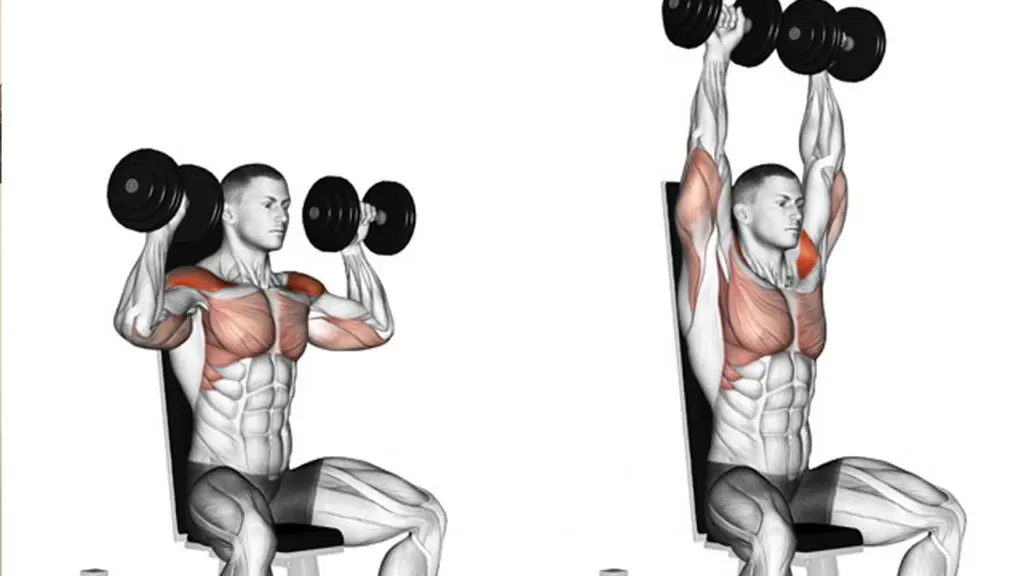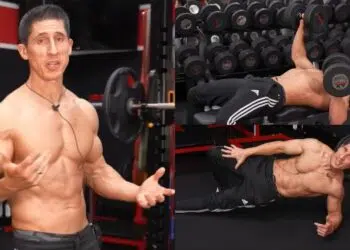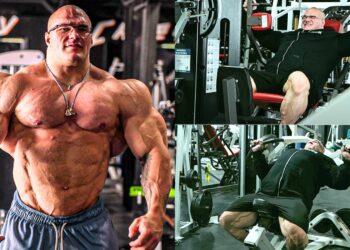An upper lower split is one of the most effective and enjoyable training routines, plus it has many benefits. It’s time-saving, less taxing on the body, and is a welcome change from most splits and full-body regimes.
But there’s a right way to do it and to save you the trouble, we’ve created a workout plan that’ll help you to make big progress while ensuring you cover everything needed to do so. The workouts we’ve devised are ideal for intermediate exercisers which covers a larger spectrum of individuals looking to continue building their physique.
So, let’s get into the details…
Upper Lower Split Workout Details
Weight training is not a complex process by any means. But there are, indeed, methods and techniques that are a must when it comes to maximizing results. Today, we’re going to include some of those and we’d be surprised if you didn’t see better gains as a result.
These techniques include utilizing unique exercises, drop sets, and pure, science-based knowledge.
This upper lower split routine is designed as a 4-day per week regime and you’re free to add in whatever you want to in between (e.g. exercises, cardio, etc). Although, we advise against working the same muscle groups with the same weight and level of intensity as this can lead to overtraining.
Level Up Your Fitness: Join our 💪 strong community in Fitness Volt Newsletter. Get daily inspiration, expert-backed workouts, nutrition tips, the latest in strength sports, and the support you need to reach your goals. Subscribe for free!
So for upper body days, you’ll train the chest, back, shoulders, arms, and core muscles (core is optional). Then for lower body days, you’ll train the legs (quads, hamstrings, calves, glutes) but you can do core on these days too, which again, is optional.
The days of the week that you train do not matter but we recommend following either of the provided layouts for the workouts. Also, how long you decide to follow this upper lower split depends on your goals, progress, and whether you just want to change things up.
Always make sure to do a few progressive warm-up sets before doing your working sets. This will ensure the safety of your joints and it’ll allow you to feel the muscles working most optimally. Also, the weight that you do use for your sets depends entirely on your current level of strength.
Do your best and just follow the routine as it is. But all we ask is that you give your best effort. If you want to progress, you have to take your training as seriously as anything else in life that you desire to see results with.
4-Day Upper Lower Workout Split
Here’s the full workout. We’ve provided links to some exercises of which you can find the movement instructions. For other exercises, we’ve provided the instructions with a video example. We’ve also provided a few different layouts for the plan. You could also create your own layout but make sure to include at least two rest days for the week.
Day 1 – Upper
Weighted chin-ups/bodyweight wide-grip pull-ups
- 2 sets x failure (rest 1 minute between sets/ after you’ve completed both exercises)
Chin-ups are a must-have back builder that emphasizes the stretch on the lat muscles but they also heavily work the biceps. The wide-grip pull-ups hit more of the teres major which sits under the upper arm and contributes to the rotator cuff (humerus functions and medial rotator).
Add 10-20 pounds of additional weight (depending on your strength level) to this lift. Use a weight belt or something similar. You can also use a dumbbell by standing with your feet together and placing the handle vertical between your feet.
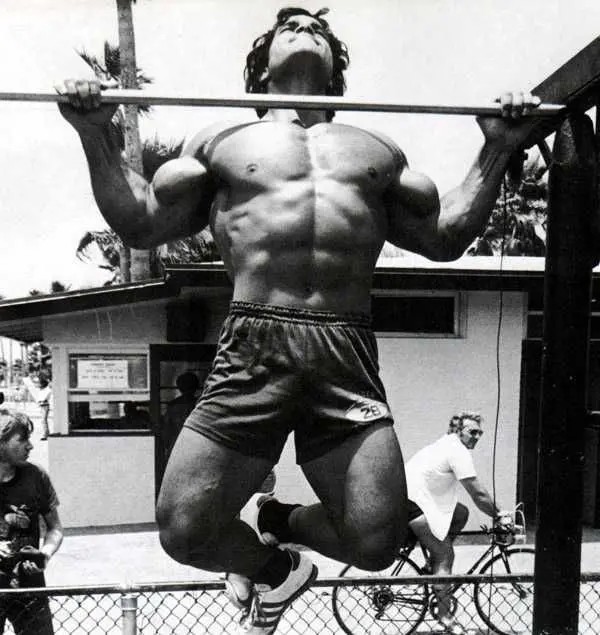
To do it:
- Grab the bar with hands shoulder-width or closer using an underhand grip so that your palms are facing you. Unshrug your shoulders to not allow your head to sink down into your neck as you hang from the bar. Maintain this during the exercise.
- Raise your feet behind you to prevent them from touching the floor. This is also important when using a dumbbell to keep it in place.
- Flex your lats and pull yourself up to the bar then slowly lower yourself back down.
- When you reach failure, drop the weight, rest 20 seconds, and complete as many wide-grip pull-ups as you can.
For the pull-ups, the form is the same as the chin-ups except your hands are, of course, positioned farther away from each other.
Kettlebell bent-over rows
- 2 sets x 10-12 reps (rest 30 seconds between sets)
There’s something about using kettlebells when doing bent-over rows that just feels different from using dumbbells. This could be due to the unique design of the kettlebell that requires some additional stabilization. But rows, in general, are ideal for targeting the upper and lower back symmetrically. And it has actually shown to be superior for this purpose when compared to many other common back exercises. (1)
You’ll obviously need two kettlebells for this exercise and it’s performed just as the dumbbell bent-over row variation is. You can also vary hand position although, most prefer the palms facing the body.
Use a challenging weight that’ll only allow you to perform with the rep range above.
Medium-grip rocking cable pulldown
- 2 sets x 8-10 reps (rest 45 seconds between sets)
The cable pulldown is one of the most commonly performed back exercises, and it’s also one of the most effective for sure. But to get a little more out of this exercise, we have a variation, of which we saw Jeff Cavaliere of Athlean-X kind of adopt, to get a better contraction in the lats/back muscles.
The rocking lat pulldown is a unique exercise because it actually involves rocking back a little which allows you to get even better adduction and extension of the arms to the sides. Therefore, we think it’s a very useful exercise for squeezing out extra muscle gains!
To do it:
- Attach a long bar to the pulldown machine and adjust the seat if you can to where when you’re holding the bar, it doesn’t cause the plates you’re lifting to touch the rest of the stack.
- Grip the bar a little wider than shoulder-width and then secure your legs under the padding. Unshrug your shoulders and pull them down so your head doesn’t sink down into your shoulders.
- Flex your lats and pull the bar down, emphasizing the range of motion on one side as you slowly rock back to get even better extension.
- Extend your arms back up to the start while slowly rocking forward and then repeat. But emphasize the range of motion on the opposite side this time.
- Alternate sides for one set.
Here’s a video example…
Weighted back extensions
- 2 sets x 12-15 reps (rest 1 minute between sets)
Back extensions are a really great exercise for working the lower back. Many will neglect the lower back but this is not recommended. The lower back is a big supporter during compound exercises and it can also be aesthetically developed as well.
Not to mention, back extensions also work the other back muscles, including the erector spinae muscles especially. By adding weight, we’re focusing on building strength and size in this area. Many people will only do this using their own bodyweight but eventually, you need more resistance to progress.
Shrugs
- 1 drop set – start with a relatively heavy load and rep out until you hit failure. Then, drop the weight by 10 pounds and repeat. Continue this until you can’t perform a single rep.
The last back exercise is the shrug which is an old-school exercise but still a very effective way to build the lower and upper traps. Use whatever you prefer for this exercise whether that’s a barbell, dumbbells, cables, or a machine.
Incline dumbbell press
- 3 sets x 6-8 reps (rest 45 seconds between sets)
The incline dumbbell press allows you to emphasize the upper chest near the clavicle. This is important for having a well-rounded chest and it definitely makes a difference.
Single-arm low-to-high cable fly
- 2 sets x 10-12 reps (rest 45 seconds between sets)
Due to the direction of the upper chest fibers, the single-arm low-to-high cable fly is a great way to stimulate this area while getting optimal arm adduction. Being able to get a maximal contraction in the chest is an essential component of chest training.
To do it:
- Attach a single-grip handle to the bottom of a cable machine.
- Grip the handle and take a step away to create tension.
- Bend your elbow slightly and contract your chest while bringing your arm up and across the top portion of your chest to follow the fibers.
- Lower the weight back down until you feel a slight stretch in your pecs and repeat.
- Don’t forget to do the other side too!
Chest-focused dips
- 2 set x failure (rest 45 seconds between sets)
The dip should be in everyone’s fitness regime. It builds all pushing muscles in addition to being a very convenient exercise that requires no equipment. For this chest-focused dip variation, we recommend using a dip stand. You can also use a bench, chair, or anything similar.
Now, the reason we specifically chose this exercise for this workout, is because it really emphasizes the lower chest or abdominal head.
To do it:
- Grip the dip bars and push yourself up so that you’re supporting your body weight. Keep your arms at a 45-degree angle to your body (not tucked or flared out) and don’t allow your head to sink into your neck.
- Lean forward and tuck your chin into your neck.
- Lower yourself down until your upper arms are parallel to the floor and then push yourself back up while squeezing your chest.
Decline inner-pec push-ups
- 2 sets x failure (rest 45 seconds between sets)
We’ll continue to hit the lower pecs but with a twist… literally! The decline inner-pec push-up is a great exercise for at the end of a chest workout. But don’t be fooled, it’s no easy “push-up”.
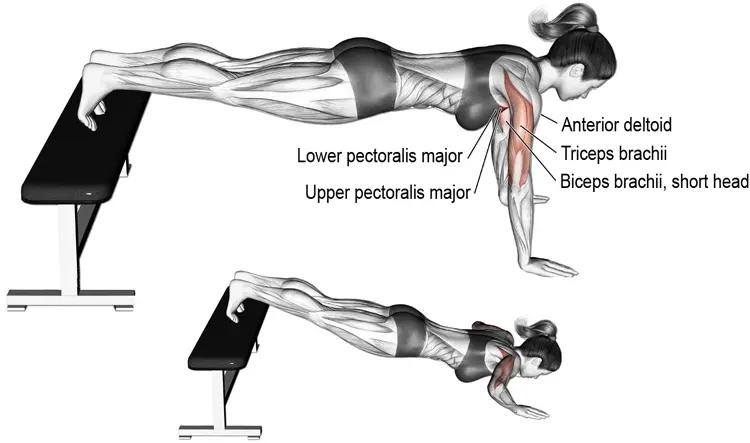
To do it:
- Get into a push-up position but elevate your upper body onto a raised object whether a bench, table, counter, chair, etc.
- Keep your torso neutral and head in line with your body and pull your shoulders back.
- Lower yourself down until your chest is almost in contact with the elevated platform. As you press up, rotate your body toward one side. You should feel a strong contraction in your chest.
- Rotate your body back to neutral and lower yourself back down.
- Press back up and rotate to the opposite side now.
- Alternate for one set.
Let’s finish off with some shoulders!
Seated dumbbell lateral raises superset w/ rear delt fly
- 2 sets x 10-12 reps each exercise rest 30 seconds between sets)
To cap off those delts, we’ll do a few sets of seated side lateral raises. Now, why we chose the seated variation as opposed to standing, is because it reduces the temptation to cheat and swing. Grab a light to moderate weight dumbbell and really focus on contracting the deltoids.
This is an exercise that really emphasizes the lateral or side deltoids that help give width to the upper body.
Then you have the dumbbell rear delt raises which works the upper posterior chain (upper backside of the body) and rotator cuff. This area is often ignored because we can’t see it from the front. But it’s as important as any other muscle. The upper posterior is highly involved in every single compound exercise as it helps to maintain proper lifting posture/thoracic extension (proper spine positioning) which is non-negotiable.
So for this superset, perform one set of the side raises and then immediately do the rear delt raises.
Day 2 – Lower
Alright, now it’s time for the lower-body portion of the upper-lower split.
Barbell front or back squats
- 4 sets x 5RM, 5 RM, 10RM, 25RM (complete 4 sets by increasing the reps as provided. RM represents rep-max which is the max number of reps you can lift the weight.
- Rest 1-2 minutes between sets
Important
Before you do these squats, do a few progressive warm-up sets (30 and 50% of one-rep max) and then one final warm-up set of 2-3 reps with a weight that is 10% more than what you’ll be using for your working sets. This will prevent injury and mentally prepare you for the working weight load.
Most would probably agree that squats are king when it comes to building leg size. And it really doesn’t matter if you choose front or back squats as research shows similar muscle activation between the two exercises. Although, front squats are better for long-term joint health due to less compressive forces and extensor moments compared to the back squat. (2)
Level Up Your Fitness: Join our 💪 strong community in Fitness Volt Newsletter. Get daily inspiration, expert-backed workouts, nutrition tips, the latest in strength sports, and the support you need to reach your goals. Subscribe for free!
Choose a moderate weight for these due to the rep range.
Forward-leaning Bulgarian split squats
- 2 sets x 10-15 reps (rest 1 minute between sets)
Bulgarian split squats are one of the best leg exercises that aren’t used enough. They involve training one leg at a time which we recommend when training for overall fitness and function. This is referred to as unilateral training and it has many benefits that include identifying and correcting muscle imbalances, improving dynamic balance, improving physical performance, hip stability, and more.
Now, there’s a standard version of this exercise where you remain mostly upright. However, this exercise involves leaning your torso forward to really activate the hamstrings.
Use dumbbells for these and don’t be afraid to use some challenging weights.
Barbell hip thrusts
- 2 sets x 8-10 reps (rest 45 seconds between sets)
An amazing glute, hamstring, and hip extension exercise, the barbell hip thrust deserves a spot in this leg workout due to its functional benefits. You should absolutely train heavy with this movement and it’s one of the best posterior strength-building movements out there.
Side plank hip adduction
- 2 sets x failure (rest 30 seconds between sets
The adductors (muscles of the legs that help bring them toward the midline of the body) are an important muscle to train and we can’t skip them for full development and function. The side plank hip adduction is an ideal exercise for targeting this area and you only need your body weight.
Lying hamstring leg curls
- 2 sets x failure (rest 30 seconds between sets)
Because the short head of the biceps femoris (hamstring muscle) only crosses the knee joint, it can only be worked by doing isolation movements such as this one. Focus on getting a full range of motion and really get a nice contraction in the hamstrings to finish things off. (3)
Day 3 – Rest or active recovery
Day 4 – Rest or active recovery
Day 5 – Upper
Alright, so the next upper day will include fewer exercises that are more compound or multi-joint in nature. Although, we’ll have you doing less volume as to not tax you from this one session. But, the intensity should still be there.
Barbell deadlift
- 2 sets x 6-8 reps (rest 1:30 between sets)
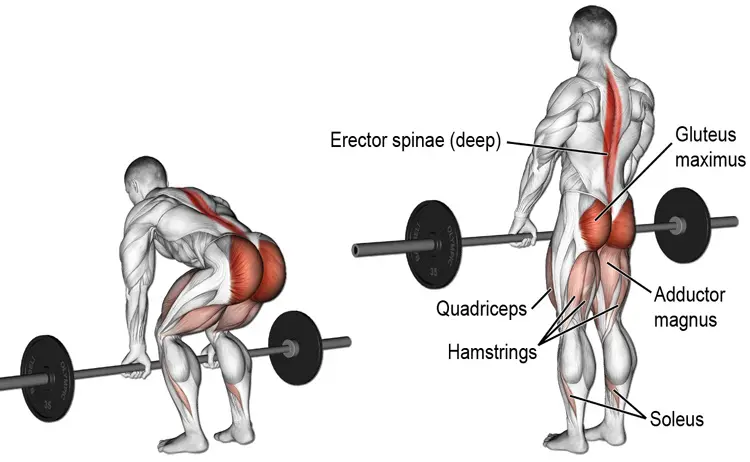
The barbell deadlift works all muscles of the body and is probably the most effective for this purpose. But today, we’ll use it for back training purposes. It’ll hammer the lats, rhomboids, traps, erector spinae, and anything else you can think of. Not to mention, it’s amazing for building a strong, rigid group of core muscles too.
Now, there will be some overlap with the deadlift for the day 6 lower-body routine but we’ve adjusted accordingly.
Standing twisting cable high row
- 2 sets x 8-12 reps (rest 30-45 seconds between sets)
The standing twisting cable high row allows for awesome extension and stretch in the lats and back muscles in general. Plus, the twist adds additional back engagement, and being on your feet makes this an effective, functional movement.
Wide-grip inverted rows
- 2 sets x failure (rest 30 seconds between sets)
Inverted rows also hit all back muscles. However, due to the position when performing this exercise, it’s great for the upper back muscles and middle fibers of the traps according to research. (1)
If you find the basic variation to be too easy, elevate your feet onto an object such as a bench to increase the resistance.
Incline I-Y-T raises
- 2 sets x failure (rest 30 seconds between sets)
In a study conducted by ACE (American Council on Exercise), researchers found that the I-Y-T raise is superior for lower and upper trap muscle activation when compared to several back exercises. (1)
It’s a unique-looking exercise that you’ve probably never seen anyone do before. But you’ll have the advantage when it comes to building your traps if you incorporate this movement in your back training.
To do it:
- Lie face down on a 30-degree incline bench with the chosen weights in hands.
- Let your arms hang down and without bending your elbows, raise your arms up directly in front you to form an “I”. Then lower your arms back down.
- Now raise your arms out to form a “Y” and then return your arms back down.
- Lastly, raise your arms out to the sides to form a “T” and then lower your arms back down.
This is considered one repetition. Although, since you’ll be taking this exercise to failure each set, there’s no need to count the reps. Just make sure you do the movements properly and in the order explained in the instructions.
Barbell bench press
- 3 sets x 6-8 reps (rest 1 minute between sets)
The classic barbell bench press is a staple in chest training routines around the world. And for good reason. It allows you to really overload the chest muscles and is a superior movement due to the amount of muscle activation, according to a study by ACE. (4)
Pike push-ups or decline push-ups
- 2 sets x failure (rest 45 seconds between sets)
If you trained with enough intensity during the barbell bench press, then you shouldn’t be able to do endless reps of either of these exercises. Although, the pike push-up or decline push-up is much more difficult than a basic push-up. But we wanted to include these variations to hit the upper chest area.
Now, the movements themselves are pretty simple and straightforward.
The Pike push-up is performed in a push-up position but you’ll actually flex your hips to raise your butt high in the air. You should look like an upside-down “V”. This shifts more of the weight onto your pushing muscles.
The decline push-up on the other hand simply involves elevating your feet up onto a raised object/platform such as a bench or something even higher for more resistance.
Here’s a video of the Pike Push-up for visual reference…
Standing hi to low cable crossover
- 2 sets x 12-15 reps (rest 45 seconds between sets)
The last chest exercise in the workout is the standing hi to low cable crossover. We want to finish off with something that hits the sternal lower or abdominal head of the pecs. Cables are an amazing and must-have training tool that allows you to get a maximal contraction in the target muscle/s.
To get an even more pronounced contraction, cross your hands during this exercise rather than just touching your hands together at the bottom.
Seated dumbbell shoulder press
- 3 sets x 10-12 reps (rest 1 minute between sets)
We can’t forget an overhead shoulder press variation and we selected the seated dumbbell shoulder press as a result. Using dumbbells works the front and lateral deltoid heads and it allows for more range of motion which is ideal.
Dumbbell curl superset w/ reverse curl
- 3 sets x 8-10 reps each exercise (rest 1 minute between supersets)
You don’t need much to stimulate the biceps and forearms especially since you’ll be doing a decent amount of back training which heavily involves these muscles. So, the basic dumbbell curl and reverse curl combo will be plenty.
Lying triceps extensions/skull crushers superset with cable tricep kickbacks
- 3 sets x 8-10 reps each exercise (rest 1 minute between supersets)
Similar situation for the triceps, the chest and shoulder work engages these muscles to a significant degree. But to ensure we isolate them for maximum development, we opted for the lying extension and cable kickbacks. These exercises really emphasize the long and medial head of the triceps which contribute a lot to their overall mass.
The lying extensions, in particular, allow for a really good stretch in the long head of the triceps which isn’t the case with presses or most triceps exercises either. On the other hand, the tricep kickback maximizes the activation of the long head due to the arms being placed behind the body.
Day 6 – Lower
For this lower-body routine, we’ve also cut the overall volume a little since you’re training twice per week in the upper-lower split.
Leg press
- 3 sets x 8-10 reps (rest 1 minute between sets)
The leg press is also a good exercise to add to any leg workout. You don’t have to stabilize the weight and therefore, you can really focus on working the leg muscles. Also, you can load up the weight due to this reason.
Dumbell rear lunges
- 2 sets x 15-20 reps (rest 45 seconds between sets)
A popular unilateral exercise, the rear lunge works all of the leg muscles and especially the glutes. Not to mention, it places less stress on the knees and so many prefer it over the forward lunge.
Barbell hip thrust
- 2 sets x 8-12 reps (rest 45 seconds between supersets)
We’ve also included the barbell hip thrust in the second lower-body workout of the week. It’s just an overall superior lower posterior movement that you can really build muscles and strength with.
Leg curls
- 2 sets x 10-12 reps (rest 45 seconds between sets)
Whether you do these lying down, seated, or standing, it’s your choice. Just make sure to use a full range of motion and really focus on squeezing the muscles to get the most out of the exercise.
That’s a wrap!
Day 7 – Rest or active recovery
Below is another weekly workout structure for the 4-day upper-lower split that you can follow.
- Day 1 – Upper
- Day 2 – Rest
- Day 3 – Lower
- Day 4 – Rest
- Day 5 – Upper
- Day 6 – Rest
- Day 7 – Lower
You might also be interested in this one as well…
- Day 1 – Upper
- Day 2 – Lower
- Day 3 – Rest or active recovery
- Day 4 – Upper
- Day 5 – Lower
- Day 6 – Rest or active recovery
- Day 7 – Rest or active recovery
Wrapping Up
We truly hope that you enjoyed this 4-day upper lower split workout routine. If you’re consistent and follow it through, there’s no reason that you won’t see awesome results. We provided a variety of exercises with effective methods that work.
So, give it a try and feel free to use it as long as it continues to allow you to progress and make gains!

